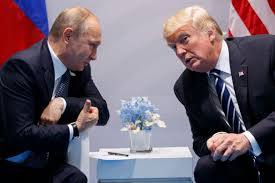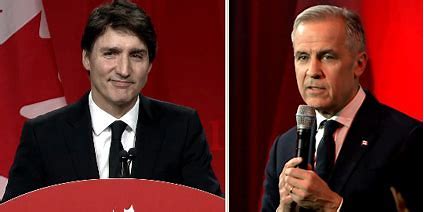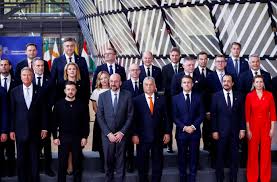Global News
Putin Expresses Conditional Support for Trump’s Ukraine Ceasefire Proposal
 Russian President Vladimir Putin announced on Thursday that Moscow is, in principle, supportive of a ceasefire in the ongoing war against Ukraine, a proposal put forward by the administration of U.S.
Russian President Vladimir Putin announced on Thursday that Moscow is, in principle, supportive of a ceasefire in the ongoing war against Ukraine, a proposal put forward by the administration of U.S.  Russian President Vladimir Putin announced on Thursday that Moscow is, in principle, supportive of a ceasefire in the ongoing war against Ukraine, a proposal put forward by the administration of U.S. President Donald Trump. However, Putin tempered his endorsement with a series of questions and conditions, signaling that the Kremlin requires further clarity and assurances before committing to any truce. The statement, delivered during a press conference in Moscow, comes amid intensified diplomatic efforts by the Trump administration to broker a pause in the conflict, which has raged for over three years since Russia’s full-scale invasion of Ukraine in February 2022.
Russian President Vladimir Putin announced on Thursday that Moscow is, in principle, supportive of a ceasefire in the ongoing war against Ukraine, a proposal put forward by the administration of U.S. President Donald Trump. However, Putin tempered his endorsement with a series of questions and conditions, signaling that the Kremlin requires further clarity and assurances before committing to any truce. The statement, delivered during a press conference in Moscow, comes amid intensified diplomatic efforts by the Trump administration to broker a pause in the conflict, which has raged for over three years since Russia’s full-scale invasion of Ukraine in February 2022.-
U.S. Envoy in Moscow: President Trump’s special envoy, Steve Witkoff, arrived in Moscow on Thursday morning and held closed-door discussions with Russian officials, potentially including Putin, late that evening. Kremlin foreign policy aide Yuri Ushakov confirmed the meeting but offered no immediate details on its outcome, stating only that the U.S. proposal “needs reworking” to account for Russia’s position. The talks are seen as a critical test of Moscow’s willingness to move forward with the ceasefire.
-
Ukrainian Reaction: In his nightly video address on Thursday, President Zelensky expressed skepticism about Putin’s intentions, suggesting that the Kremlin’s conditions are a stalling tactic. “That’s why in Moscow they are imposing upon the idea of a ceasefire these conditions—so that nothing happens at all, or so that it cannot happen for as long as possible,” Zelensky said. Ukrainian officials hope Trump will redirect his pressure toward Putin if Russia balks at the proposal.
-
European Concerns: European leaders, wary of Trump’s pivot toward Moscow, are bracing for potential shifts in transatlantic security dynamics. French President Emmanuel Macron and UK Prime Minister Keir Starmer are convening a meeting of European leaders on Saturday to discuss a “coalition of the willing” to support a permanent truce, excluding U.S. troop involvement per Trump’s stance against American boots on the ground.
-
Battlefield Developments: Russian forces continue their offensive in Kursk, with reports indicating Ukrainian troops are increasingly encircled. A U.S. official told CBS News on Wednesday that Kyiv may soon face a choice between withdrawal or losing supply lines, a scenario Putin referenced in his press conference as a point of leverage.
Ukraine to Propose Partial Ceasefire Plan to United States Amid Shifting Support Dynamics
.jpeg) In a significant diplomatic move, Ukraine is set to present a detailed proposal for a partial ceasefire with Russia to the United States on Tuesday, aiming to reinvigorate backing from its most crit
In a significant diplomatic move, Ukraine is set to present a detailed proposal for a partial ceasefire with Russia to the United States on Tuesday, aiming to reinvigorate backing from its most crit
.jpeg) In a significant diplomatic move, Ukraine is set to present a detailed proposal for a partial ceasefire with Russia to the United States on Tuesday, aiming to reinvigorate backing from its most critical ally. The plan comes as the administration of U.S. President Donald Trump has increasingly pressured Kyiv to make concessions to bring an end to the nearly three-year-old conflict, which has devastated Ukraine’s infrastructure, displaced millions, and strained international alliances.
In a significant diplomatic move, Ukraine is set to present a detailed proposal for a partial ceasefire with Russia to the United States on Tuesday, aiming to reinvigorate backing from its most critical ally. The plan comes as the administration of U.S. President Donald Trump has increasingly pressured Kyiv to make concessions to bring an end to the nearly three-year-old conflict, which has devastated Ukraine’s infrastructure, displaced millions, and strained international alliances.Change of Leadership in Canada
 The transition from Justin Trudeau as the former Prime Minister of Canada to Mark Carney as the new Prime Minister marks a significant shift in Canadian leadership, reflecting both internal political
The transition from Justin Trudeau as the former Prime Minister of Canada to Mark Carney as the new Prime Minister marks a significant shift in Canadian leadership, reflecting both internal political  The transition from Justin Trudeau as the former Prime Minister of Canada to Mark Carney as the new Prime Minister marks a significant shift in Canadian leadership, reflecting both internal political dynamics and external pressures. Below is a discussion of Trudeau’s exit and Carney’s arrival, based on the context of events as of March 11, 2025.
The transition from Justin Trudeau as the former Prime Minister of Canada to Mark Carney as the new Prime Minister marks a significant shift in Canadian leadership, reflecting both internal political dynamics and external pressures. Below is a discussion of Trudeau’s exit and Carney’s arrival, based on the context of events as of March 11, 2025.-
Internal Party Strife: A pivotal moment came with the resignation of his Deputy Prime Minister and Finance Minister, Chrystia Freeland, on December 16, 2024. Freeland’s exit, following a public disagreement with Trudeau over fiscal policy and preparation for a potential U.S. trade war under President Donald Trump, signaled deep divisions within the Liberal cabinet. Her departure was a blow to Trudeau’s authority and intensified calls from within the party for him to step down.
-
Public Discontent: Trudeau’s popularity had been waning due to domestic issues like rising housing costs, inflation, and a perceived mishandling of immigration policies, which strained public services. By late 2024, his approval rating had dropped to 22%, reflecting widespread dissatisfaction. Scandals, such as the "brownface" controversy and the use of emergency powers during the 2022 Freedom Convoy protests, further tarnished his progressive image.
-
External Pressure: The re-election of Donald Trump in the United States added urgency to Trudeau’s challenges. Trump’s threats of 25% tariffs on Canadian exports and his provocative suggestion that Canada become the “51st state” heightened economic and sovereignty concerns. Critics argued that Trudeau was ill-equipped to counter Trump’s aggressive stance, amplifying demands for fresh leadership.
-
Background and Credentials: Carney, a former Governor of both the Bank of Canada (2008–2013) and the Bank of England (2013–2020), brings a unique profile to the role. A political outsider with no prior elected office, he is the first Canadian Prime Minister without a parliamentary background at the time of appointment. His expertise in managing economic crises and his role as a UN Special Envoy on Climate Action positioned him as a candidate capable of addressing Canada’s economic and international challenges.
-
Leadership Context: Carney assumes office amid a trade war with the United States, triggered by Trump’s tariffs. In his victory speech, he vowed to resist these pressures, stating, “Donald Trump has put unjustified tariffs on what we build… We cannot let him succeed, and we won’t.” His economic acumen is seen as a strategic asset to navigate this crisis and maintain Canada’s sovereignty.
-
Political Challenges: As a non-MP, Carney must seek a seat in the House of Commons soon, per convention, though he can legally serve as Prime Minister without one temporarily. His landslide win suggests strong party support, but he faces a looming general election—required by October 20, 2025, though possibly called earlier—where the resurgent Conservative Party, led by Pierre Poilievre, holds a significant polling lead (47% to the Liberals’ 18% as of early 2025). The Liberals’ revival under Carney will be tested against Poilievre’s populist momentum.
News Article: Muslim Nations Back Palestinian-Led Governance Plan for Gaza Reconstruction
Jeddah, Saudi Arabia – March 08, 2025
 Foreign ministers from the 57-member Organization of Islamic Cooperation (OIC) convened an emergency meeting in Jeddah on Saturday, adopting a regional plan to est
Foreign ministers from the 57-member Organization of Islamic Cooperation (OIC) convened an emergency meeting in Jeddah on Saturday, adopting a regional plan to est
Jeddah, Saudi Arabia – March 08, 2025
 Foreign ministers from the 57-member Organization of Islamic Cooperation (OIC) convened an emergency meeting in Jeddah on Saturday, adopting a regional plan to establish a Palestinian administrative committee to govern Gaza. The initiative aims to facilitate the territory’s early recovery and reconstruction amid ongoing devastation, positioning itself as a counterproposal to a controversial U.S. suggestion under President Donald Trump to assume control of Gaza and displace its residents.
Foreign ministers from the 57-member Organization of Islamic Cooperation (OIC) convened an emergency meeting in Jeddah on Saturday, adopting a regional plan to establish a Palestinian administrative committee to govern Gaza. The initiative aims to facilitate the territory’s early recovery and reconstruction amid ongoing devastation, positioning itself as a counterproposal to a controversial U.S. suggestion under President Donald Trump to assume control of Gaza and displace its residents.
The OIC’s communique formally endorsed the plan, stating it “adopts the plan… on the early recovery and reconstruction of Gaza.” The decision follows the Arab League’s ratification of the same proposal three days earlier at a summit in Cairo, signaling a unified regional push to address Gaza’s governance and rebuilding needs. The OIC called on the international community to rally behind the initiative, framing it as a viable alternative to external intervention.
Egyptian Foreign Minister Badr Abdelatty hailed the OIC’s endorsement as a critical step forward, expressing optimism about broadening its support base. “The next step is for the plan to become an international plan through adoption by the European Union and international parties such as Japan, Russia, China, and others,” Abdelatty told reporters. He emphasized the need for global backing to ensure the plan’s success, particularly in light of opposition from key players like the United States and Israel.
The proposal, however, notably excludes any role for Hamas, the Palestinian militant group currently controlling Gaza, raising questions about its feasibility and acceptance among local stakeholders. Both the U.S. and Israel have already dismissed the plan, with U.S. State Department spokeswoman Tammy Bruce stating last week that it “does not meet the expectations” of Washington. Israel, a key actor in the region, has similarly signaled its rejection, though specifics from its government remain limited.
Despite this, Trump’s Middle East envoy, Steve Witkoff, offered a more nuanced response, describing the Egyptian-led proposal as a “good-faith first step.” His comments suggest potential room for dialogue, even as the broader U.S. stance remains skeptical.
The plan’s adoption marks a significant moment of solidarity among Muslim nations, but its path forward remains fraught with challenges. Analysts note that excluding Hamas could complicate implementation, given the group’s entrenched influence in Gaza. Furthermore, the lack of U.S. and Israeli buy-in—coupled with Trump’s alternative vision—may hinder the international support Abdelatty seeks.
As the OIC and Arab League push this initiative, the global community watches closely. Will this Palestinian-led administrative framework gain traction, or will it falter under the weight of geopolitical opposition? For now, the stage is set for a high-stakes diplomatic showdown over Gaza’s future.
Editorial Discussion:
This development reflects a proactive effort by Muslim nations to assert regional influence over Gaza’s fate, directly challenging U.S. and Israeli dominance in shaping the territory’s post-conflict trajectory. The exclusion of Hamas is a strategic choice, likely aimed at appealing to Western powers wary of the group’s militant history, but it risks alienating Gaza’s current leadership and populace. The OIC’s call for international support is ambitious, yet the immediate rejection by the U.S. and Israel underscores the uphill battle ahead. Trump’s proposal to “take over Gaza and displace its residents” looms as a polarizing counterpoint, amplifying tensions between regional and Western visions. The plan’s success hinges on whether Egypt and its allies can secure broader buy-in—particularly from the EU, Russia, and China—while navigating the complex realities on the ground.

